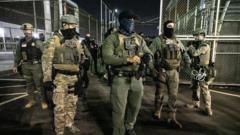A BBC report reveals half a million US weapons left in Afghanistan have been lost or sold, potentially empowering militant factions like al-Qaeda.
Weapons Left Behind in Afghanistan Fuel Militant Groups: A BBC Investigation

Weapons Left Behind in Afghanistan Fuel Militant Groups: A BBC Investigation
Abandoned American military equipment sold to insurgents, including al-Qaeda affiliates, raising security concerns globally.
The Taliban regained control of Afghanistan in 2021, seizing around one million weapons and equipment, many of which were funded by the US. According to anonymous sources speaking to the BBC, an estimated half a million of these weapons are now unaccounted for, having either been lost, sold, or smuggled to militant groups, including affiliates of al-Qaeda. The revelations come amid growing concerns regarding security in the region as the United Nations reports ongoing transactions of Taliban-captured weapons on the black market.
When the Taliban took power, many Afghan soldiers left their arms behind as they either surrendered or fled. The military inventory includes American-made firearms, such as M4 and M16 rifles, alongside older weaponry from many years of conflict. A closed-door UN Security Council meeting in Doha revealed the Taliban's admission that a large portion of seized weapons remains untraceable, corroborated by various sources.
Certain militant factions, such as Tehreek-e-Taliban Pakistan and Yemen's Ansarullah movement, are reportedly accessing or purchasing weapons from the Taliban's captured arsenal. Hamdullah Fitrat, deputy spokesperson for the Taliban, denied claims of smuggling or loss and assured that all weapons were securely stored. However, UN investigations showed that local Taliban commanders are often permitted to retain around 20% of captured US weapons, contributing to a thriving black market.
The market for arms has shifted underground, especially after the initial surge following the Taliban takeover, becoming a phenomenon observed on messaging platforms like WhatsApp. Here, local commanders and affluent individuals continue trading both new and used American weaponry left by outgoing US-backed forces. The official monitoring body for Afghan reconstruction projects, known as Sigar, reports that the scope of tracking these arms remains challenging because of ongoing bureaucratic shortfalls.
The organization has criticized the inadequate tracking processes of the Department of Defense, while the State Department has refuted such claims. The political repercussions of these findings have been significant, with former President Donald Trump vocally insisting on the reclamation of this military equipment, asserting that billions of dollars’ worth of advanced weaponry has been abandoned in Afghanistan. However, many analysts question the feasibility of reclaiming such arms, citing logistical and financial impracticality.
Despite the Taliban's assertions of weapon security, their armed capability has undeniably increased, enabling them to overpower rival factions like the National Resistance Front. Although advanced equipment such as Black Hawk helicopters remains largely inoperable due to a lack of trained personnel, the Taliban still utilizes simpler weapons like Humvees and small arms effectively in their military operations.
As discussions persist over potential actions regarding these abandoned arms from the US, the broader implications for regional security and the empowerment of militant groups continue to raise alarms.
When the Taliban took power, many Afghan soldiers left their arms behind as they either surrendered or fled. The military inventory includes American-made firearms, such as M4 and M16 rifles, alongside older weaponry from many years of conflict. A closed-door UN Security Council meeting in Doha revealed the Taliban's admission that a large portion of seized weapons remains untraceable, corroborated by various sources.
Certain militant factions, such as Tehreek-e-Taliban Pakistan and Yemen's Ansarullah movement, are reportedly accessing or purchasing weapons from the Taliban's captured arsenal. Hamdullah Fitrat, deputy spokesperson for the Taliban, denied claims of smuggling or loss and assured that all weapons were securely stored. However, UN investigations showed that local Taliban commanders are often permitted to retain around 20% of captured US weapons, contributing to a thriving black market.
The market for arms has shifted underground, especially after the initial surge following the Taliban takeover, becoming a phenomenon observed on messaging platforms like WhatsApp. Here, local commanders and affluent individuals continue trading both new and used American weaponry left by outgoing US-backed forces. The official monitoring body for Afghan reconstruction projects, known as Sigar, reports that the scope of tracking these arms remains challenging because of ongoing bureaucratic shortfalls.
The organization has criticized the inadequate tracking processes of the Department of Defense, while the State Department has refuted such claims. The political repercussions of these findings have been significant, with former President Donald Trump vocally insisting on the reclamation of this military equipment, asserting that billions of dollars’ worth of advanced weaponry has been abandoned in Afghanistan. However, many analysts question the feasibility of reclaiming such arms, citing logistical and financial impracticality.
Despite the Taliban's assertions of weapon security, their armed capability has undeniably increased, enabling them to overpower rival factions like the National Resistance Front. Although advanced equipment such as Black Hawk helicopters remains largely inoperable due to a lack of trained personnel, the Taliban still utilizes simpler weapons like Humvees and small arms effectively in their military operations.
As discussions persist over potential actions regarding these abandoned arms from the US, the broader implications for regional security and the empowerment of militant groups continue to raise alarms.





















